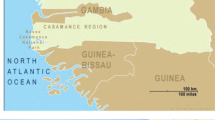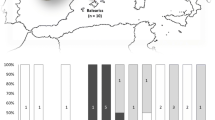Abstract
The aim of this paper was to assess the influence of diet on the concentrations of total mercury (HgTOT) in the eggs of aquatic birds. Trophic level was determined using stable isotopes (δ15N, δ13C). Analysis was carried out on eggs (laid in 2010–2012) belonging to two species of terns nesting at the River Vistula outlet on the Gulf of Gdansk and on herring gulls nesting both in Gdynia harbour and on the Vistula dam in Wloclawek. The results show that seafood diet causes the highest load of mercury, that which is transferred into terns eggs. The amounts of accumulated mercury obtained were found to be different in the particular egg components with Hgalbumen > Hgyolk > Hgmembrane > Hgshell. In the herring gull eggs, three stages of embryo development with varying levels of mercury were determined. It was observed that mercury received from the albumen and yolk was most effectively removed when developing embryo into down.



Similar content being viewed by others
References
Akearok JA, Hebert CE, Braune BM, Mallory ML (2010) Inter- and intraclutch variation in egg mercury levels in marine bird species from the Canadian Arctic. Sci Total Environ 408:836–840
Becker PH (1992) Egg mercury levels decline with the laying sequence in charadriiformes. Bull Environ Contam Toxicol 48:762–767
Becker PH, Furness RW, Henning D (1993) Mercury dynamics in young common tern (Sterna hirundo) chicks from a polluted environment. Ecotoxicology 2:33–40
Becker PH, Henning D, Furness RW (1994) Differences in mercury contamination and elimination during feather development in gull and tern broods. Arch Environ Contam Toxicol 27:162–167
Bełdowski J, Miotk M, Pempkowiak J (2009) Mercury fluxes through the sediment water interface and bioavailability of mercury in southern Baltic Sea sediments. Oceanologia 51:263–285
BirdLife International (2013) Important Bird Areas factsheet: Vistula river mouth. Downloaded from http://www.birdlife.org/ on 04/01/2013
Bojakowska I, Gliwicz T, Sokołowska G, Strzelecki R, Wołkicz S (1999) Investigation of bottom sediments in Włocławek Reservoir, the proposition to solve the problem. Synthesis. Polski Instytut Geologiczny (manuscrupt in Polish)
Bond AL, Diamond AW (2009a) Total and methyl mercury contaminations in seabird feathers and eggs. Arch Environ Contam Toxicol 56:286–291
Bond AL, Diamond AW (2009b) Mercury concentrations in seabird tissues from Machias Seal Island, New Brunswick, Canada. Sci Total Environ 407:4340–4347
Braune BM (2007) Temporal trends of organochlorines and mercury in seabirds eggs from the Canadian Arctic, 1975–2003. Environ Pollut 148:599–613
Braune BM, Gaskin DE (1987) Mercury levels in Bonaparte’s gulls (Larus Philadelphia) during autumn molt in the Quoddy region, New Brunswick, Canada. Arch Environ Contam Toxicol 16:539–549
Burger J (1993) Metals in avian feathers: bioindicators of environmental pollution. Rev Environ Contam Toxicol 5:203–311
Burger J, Gochfeld M (1997) Risk, mercury levels, and birds: relating adverse laboratory effects to field biomonitoring. Environ Res 75:160–172
Burger J, Gochfeld M (2003) Spatial and temporal patterns in metal levels in eggs of common terns (Sterna hirundo) in New Jersey. Sci Total Environ 311:91–100
Burgess NM, Bond AL, Hebert CE, Neugebauer E, Champoux L (2013) Mercury trends in herring gull (Larus argentatus) eggs from Atlantic Canada, 1972–2008: temporal trend or dietary shift? Environ Pollut 172:216–222
Cotin J, García-Tarrasón M, Sanpera C, Jover L, Ruiz X (2011) Sea, freshwater or saltpans? Foraging ecology of terns to assess mercury inputs in a wetland landscape: The Ebro Delta. Estuarine. Coastal Shelf Sci 92:188–194
Evers DC, Savoy LJ, DeSorbo CR, Yates DE, Hanson W, Taylor KM, Siegel LS, Cooley JH, Bank MS, Major A, Munney K, Mower BF, Vogel HS, Schoch N, Porkas M, Goodale MW, Fair J (2008) Adverse effects from environmental mercury loads on breeding common loons. Ecotoxicology 17:69–81
Falkowska L, Reindl AR, Szumiło E, Kwaśniak J, Staniszewska M, Bełdowska M, Lewandowska A, Krause I (2013) Mercury and chlorinated pesticides on the highest level of the food web as exemplified by herring from the southern Baltic and African penguins from zoo. Water Air Soil Pollut 224:1549–1563
Gierszewski P (2008) Koncentracja metali ciężkich w osadach zbiornika włocławskiego jako wskaźnik hydrodynamicznych warunków depozycji. Landform Anal 9:79–82 (in Polish)
Hall ED, Bodaly RA, Fudge RJP, Rudd JWM, Rosenberg DM (1997) Food as the dominant pathway of methylmercury uptake by fish. Water Air Soil Pollut 100:13–24
Heinz GH, Hoffman DJ, Kondrad SL, Erwin CA (2006) Factors affecting the toxicity of methylmercury injected into eggs. Arch Environ Contam Toxicol 50:264–279
Heinz GH, Hoffman DJ, Klimstra JD, Stebbins KR, Kondrad SL, Erwin CA (2009) Arch Environ Contam Toxicol 56:129–138
Hobson KA, Clark RG (1992a) Assessing avian diets using stable isotopes I: turnover of 13C in tissues. Condor 94:181–188
Hobson KA, Clark RG (1992b) Assessing avian diets using stable isotopes II: factors affecting diet–tissue fractionation. Condor 94:189–197
IMGW (2011) In: Maciejewski M, Ostojski MS, Walczykiewicz T (eds) Dorzecze Wisły: monografia powodzi – maj – czerwiec 2010. IMGW – PIB, Warszawa, in Polish
Kelly JF (2000) Stable isotopes of carbon and nitrogen in the study of avian and mammalian trophic ecology. Can J Zool 78:1–27
Kenov KP, Hines RK, Meyer MW, Suarez SA, Gray BR (2010) Effects of methylmercury exposure on the behavior of captive–reared common loon (Gavia immer) chicks. Ecotoxicology 19:933–944
Lavoie RA, Champoux L, Rail J, Lean DRS (2010) Organochlorines and brominated flame retardants and mercury levels in six seabird species from the Gulf of St. Lawrence (Canada): relationships with feeding ecology and molt. Environ Pollut 158:2189–2199
Meissner W, Staniszewska J, Bzoma S (2007) Abundance, species composition and age structure of gulls Laridae in the Gulf of Gdańsk area during non-breeding season. Notatki Ornitologiczne 48:67–81 (in Polish)
Meissner W, Bzoma S, Zięcik P, Wybraniec M (2014) Nesting of Sandwich Tern Sterna sandvicensis in Poland in 2006–2013. Ornis Polonica 55:96–104 (in Polish)
Minagawa M, Wada E (1984) Stepwise enrichment of 15N along food chains: further evidence and the relation between δ15N and animal age. Geochim Cosmochim Acta 48:1135–1140
Monteiro LR, Furness RW (1995) Seabirds as monitors of mercury in the marine environment. Water Air Soil Pollut 80:851–870
Monteiro LR, Granadeiro JP, Furness RW, Oliveira P (1999) Contemporary patterns of mercury contamination in the Portuguese Atlantic inferred from mercury concentrations in seabird tissues. Mar Environ Res 47:137–156
Murawiec D, Gajecka A, Bełdowska M, Falkowska L (2007) Investigation on mercury concentration levels in coastal and offshore waters of the Gulf of Gdańsk. Oceanol Hydrobiol Stud 36:83–97
Peterson BJ, Fry B (1987) Stable isotopes in ecosystem studies. Annu Rev Ecol Syst 18:293–320
Rumbold DG, Niemczyk SL, Fink LE, Chandraesekhar T, Harkanson B, Laine KA (2001) Mercury in eggs and feathers of great egrets (Ardea albus) from the Florida Everglades. Arch Environ Contam Toxicol 41:501–507
Rutkiewicz J, Basu N (2013) Methylmercury egg injections: part 1—tissue distribution of mercury in the avian embryo and hatchling. Ecotoxicol Environ Saf 93:68–76
Saniewska D, Bełdowska M, Bełdowski J, Saniewski M, Kwaśniak J, Falkowska L (2010) Distribution of mercury in different environmental compartments in the aquatic ecosystem of the coastal zone of Southern Baltic Sea. J Environ Sci 22:1144–1150
Saniewska D, Bełdowska M, Bełdowski J, Saniewski M, Falkowska L (2014) Mercury loads into the sea associated with extreme flood. Environ Pollut 191:93–100
Scheuhammer AM, Perrault JA, Bond DE (2001) Mercury, methylmercury, and selenium concentrations in eggs of common loons (Gavia imer) from Canada. Environ Monit Assess 72:79–94
Scheuhammer AM, Meyer MW, Sandheinrich MB, Murray MW (2007) Effects of environmental methylmercury on the health of wild birds, mammals, and fish. Ambio 36:12–18
Splading MG, Frederick PC, McGill HC, Bouton SN, Richey LJ, Schumacker IM, Blackmore CGM, Harrison J (2000) Histologic, neurologic, and immunologic effects of methylmercury in captive great egrets. J Wildl Dis 36:423–435
Steele KW, Daniel RM (1978) Fractionation of nitrogen isotopes by animals: a further complication to the use of variations in the natural abundance of 15N for tracer studies. J Agric Sci 90:7–9
Stężycka E, Bzdęga J, Pawlikowska K, Siwicki A (2005) Content of mercury in fish from Wisła between 1998 and 2002. Probl Hig Epidemiol 86:27–29 (in Polish)
Thompson DR (1996) Mercury in birds and terrestrial mammals. In: Bayer WN, Heinz GH, Redmon-Norwood AW (eds) Environmental contaminants in wildlife: interpreting tissue concentrations. SETAC Special Publication Series. CRC Press, Boca Raton, pp 341–356
Walsh PM (1990) The use of seabirds as monitors of heavy metals in the marine environment. In: Furness RW, Rainbow PS (eds) Heavy metals in the marine environment. CRC Press, New York
Wängberg I, Munthe J, Pirrone N, Inverfeldt A, Bahlman E, Costa P, Ebinghaus R, Feng X, Ferrara R, Gardfelt K, Kock H, Lanzillotta E, Mamane Y, Mas F, Melamed E, Osnat Y, Prestbo E, Sommar J, Schmolke S, Dpain G, Spovieri F, Tuncel G (2001) Atmospheric mercury distribution in Northern Europe and in Mediterranean region. Atmos Environ 35:3019–3025
Wiener JG, Krabbenhoft DP, Heinz GH, Scheuhammer AM (2003) Ecotoxicology of mercury. In: Hoffman DJ, Rattner BA, Burton GA Jr, Cairns J Jr (eds) Handbook ecotoxicology, sd ed. CRC Press, Boca Raton, pp 409–463
Yin X, Xia L, Sun L, Luo H, Wang Y (2008) Animal excrement: a potential biomonitor of heavy metal contamination in the marine environment. Sci Total Environ 399:179–185
Zarządzenie Ministra Ochrony Środowiska, Zasobów Naturalnych i Leśnictwa z dnia 9 października 1991 r. w sprawie uznania za rezerwaty przyrody (M.P. Nr 38, item 273) (in Polish)
Acknowledgments
The present paper was created with the financial support of the Polish Ministry of Science and Higher Education within the framework of the research project No. N N304 161637.
Author information
Authors and Affiliations
Corresponding author
Additional information
Responsible editor: Philippe Garrigues
Highlights
Hg concentration in avian eggs is determined by type and origin of food.
Albumens contained the highest Hg concentrations due to Hg’s affinity to -SH groups.
Herring gull embryos accumulate Hg in the liver and heart and sequester it in down.
Herring gull chicks rapidly eliminate mercury after hatching.
Rights and permissions
About this article
Cite this article
Grajewska, A., Falkowska, L., Szumiło-Pilarska, E. et al. Mercury in the eggs of aquatic birds from the Gulf of Gdansk and Wloclawek Dam (Poland). Environ Sci Pollut Res 22, 9889–9898 (2015). https://doi.org/10.1007/s11356-015-4154-y
Received:
Accepted:
Published:
Issue Date:
DOI: https://doi.org/10.1007/s11356-015-4154-y




